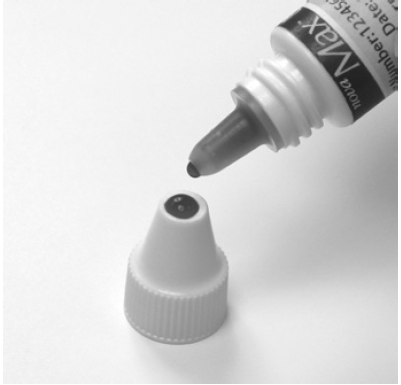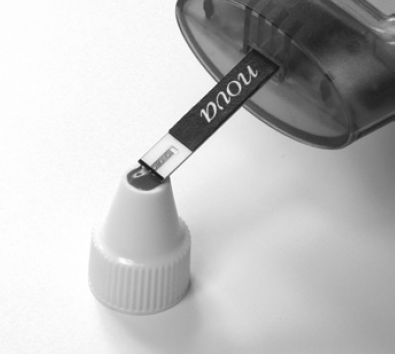| - Equipment and Materials
- Equipment
- Nova Max Blood Glucose Monitor
- Nova Max Glucose Test Strips
- Sterile Single-Use Safety Lancet (no need for additional Lancing Devices)
- Materials
- Gloves
- Gauze, cotton ball, or bandage
- Prior to Performing Test
- The prescriber shall place the order in the Integrated Behavioral Health Information System (IBHIS) prior to the authorized personnel performing the test. Authorized personnel may also perform the test in accordance with a written protocol approved by the DMH Pharmacy and Therapeutics Committee.
- Authorized personnel shall review the order in IBHIS.
- Authorized Personnel shall ask client to state or provide at least two (2) unique identifiers. Unique identifiers shall be any combination of the following
- Last Name, First Name
- Date of Birth (DOB)
- IBHIS Number
- Last 4 digits of Social Security Number (SSN)
- Address
- Phone Number
- Authorized personnel shall follow universal precautions.
- Authorized personnel shall explain the procedure to the client and provide all necessary equipment and material.
- Authorized personnel may provide education to the client on how to self-administer the blood glucose test.
- Authorized personnel performing the test shall wear gloves.
- Specimen Collection
- Instruct the client to wash their hands with soap and water and then dry their hands thoroughly. DO NOT USE ALCOHOL or hand sanitizers to disinfect the puncture site.
- Remove the test strip from the vial and recap the vial immediately.
- Insert test strip into the test port with the contact bars end first and facing up. Push the test strip in firmly until it will go no farther.

- The blood glucose monitor will then turn on automatically. All segments will display briefly. After the segments display, the blinking “BLOOD DROP SYMBOL” will appear.
- Instruct client to massage finger and thumb toward tip to stimulate blood flow. While holding the safety lancet, twist cap a full turn (360 degrees) to remove and discard. Do not apply pressure to activation button while removing protective cap to avoid prematurely activating the lancet. Press the lancet firmly against the fingertip or palm and press the activation button to pierce the sample site. Discard entire used lancet in a sharps container immediately. DO NOT reuse safety lancet.
- Apply a round drop of blood to the test strip by holding the blood drop to the top edge of the test strip until the blood has been drawn into the test strip wells.
- DO NOT push the finger against the test strip or try to apply a smeared sample.
- If the test strip wells do not fill with blood completely before the meter begins to count down, do not add more blood to the test strip. Discard that test strip and retest with a fresh test strip.
- Provide client with gauze, cotton ball, or bandage and instruct client to apply pressure on sample site following collection to stop the bleeding.
- The display counts down from five (5) seconds as the monitor performs the test. Blood glucose results appear on the display in five (5) seconds.
- The result is then stored in the monitor memory.
- Removing the test strip shall automatically turn off the monitor.
- Discard the used test strip.
- Quality Control
- Perform a control solution test the same way a blood glucose test is performed except a control solution is used in place of a blood drop.
- Shake the control solution vigorously prior to applying it to the test strip.
- The control solution can be applied to a clean, dry, hard surface that can be wiped after the test such as a control solution cap. Bring the blood glucose monitor with the test strip inserted close to the drop of the control solution.
 
- Compare the control solution test result with the expected range on the test strip vial label.
- Repeat the test if the control solution test result falls outside of the expected range. Reasons for results falling outside of range include:
- Error in performing the test. Retest and follow the test instructions carefully.
- Failure to shake the control solution vial well enough (must shake vigorously).
- Expired or contaminated control solution. Check the expiration date on the control solution vial. The control solution is good for only 3 months after opening. Make sure the control solution vial is closed when not in use.
- Expired test strip. Check the expiration date and discard date on the test strip vial.
- Test strip deterioration. This can be caused by extreme temperatures or by leaving the test strip vial cap open.
- Result Interpretation
- Limitations
- Nova Max test result range is limited to 20 mg/dL to 600 mg/dL.
- The test strips should not be used to diagnose diabetes or Diabetic Ketoacidosis (DKA).
- DO NOT use serum or plasma for testing. Use only fresh capillary whole blood.Extreme humidity, higher than 90% and lower than 10%, may affect results.
- Glucose test results may be falsely low if the client is severely dehydrated.
- Critically ill clients shall not be tested with the Nova Max Plus monitor
- Note
- Blood glucose results are shown in the monitor in mg/dL.
- When the battery indicator appears on-screen, there will only be enough battery to perform 20 more tests
- Normal Glucose Values
- Normal fasting blood glucose: 70-110 mg/dL.
- One (1) to two (2) hours after meals: less than 140 mg/dL.
- Low Glucose Values:
- If test result is lower than 20 mg/dL, “LO” will appear on the meter display. This indicates severe hypoglycemia. Repeat the test using a new test strip to confirm result and inform the prescriber immediately regardless of the client's symptoms.
- High Glucose Values
- If the test result is above 600 mg/dL, “HI” will appear on the monitor display. This indicates severe hyperglycemia. Repeat the test using a new test strip to confirm result and inform the prescriber immediately regardless of the client's symptoms.
- Error Messages
- E-2 errors represent a temperature error. The monitor is outside the required temperature range. Move the monitor to a warmer or cooler area and wait for a few minutes.
- E-4 errors represent the incorrect application of the blood sample or control solution onto the test strip or the test strip may be damaged.
- Documentation
- Authorized personnel shall document results in IBHIS as point-of-care glucose test results.
| |
|